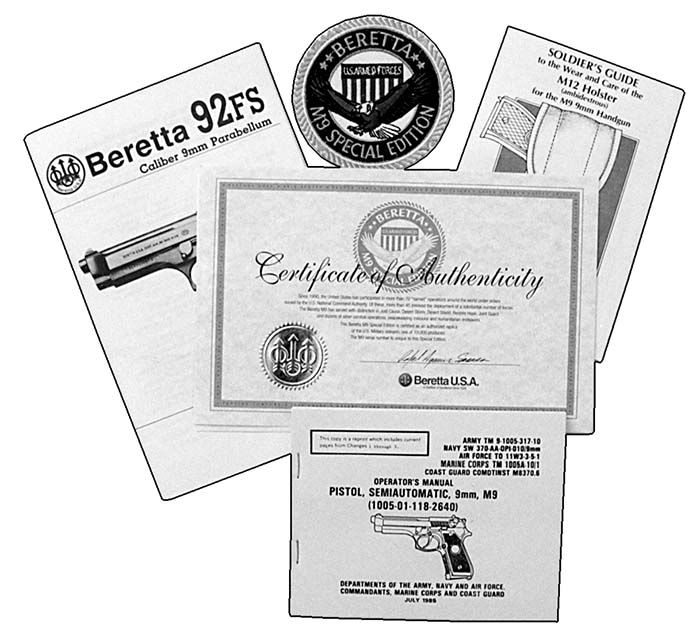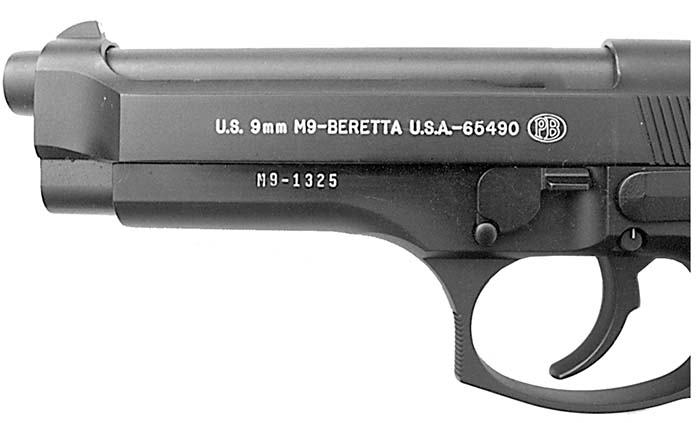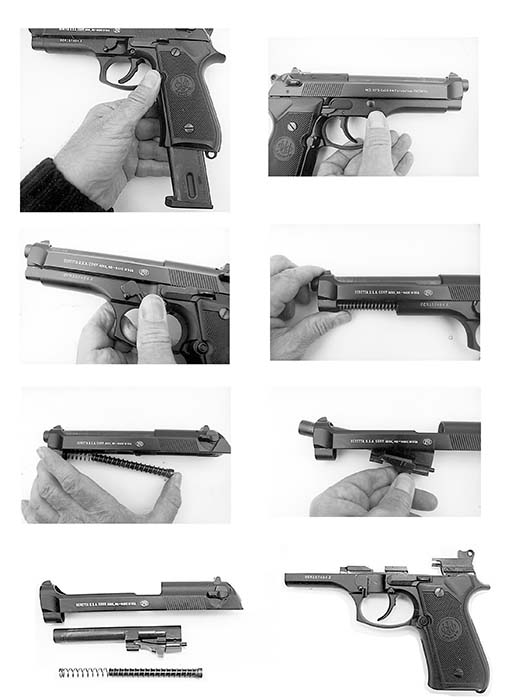By Frank Iannamico
In a Department of the Army memorandum dated 14 January 1985 it was officially announced that the U.S. military would begin replacing its tried and true .45 1911A1 semi automatic service pistol. Its successor would be the 9mm Beretta Model 92F or, as it would be officially known, the M9 Personal Defense Weapon (PDW).
It was an announcement that many die-hard Government model fans knew was coming. The 1911 and 1911A1 pistols and the .45 ACP cartridge have enjoyed an enormous following among military and civilian shooters. It remains one of the most popular handguns of all time.
The single action, 7 round capacity, 1911 and 1911A1 pistols were issued to troops for almost 75 years. The Ithaca Gun Company manufactured the last 1911A1 military pistol in 1945. The military had on several occasions considered stopping the issue of handguns altogether. They felt that handguns were a defensive weapon only, and inaccurate in most soldiers’ hands at distances beyond 10 feet. The U.S. M1 carbine was developed and adopted specifically to replace the military .45 pistol during World War Two. It never quite accomplished that goal.
The military “powers that be” did not share the admiration and sentiments for the old war-horse 1911 pistols. In 1978 the House Appropriations Committee Surveys and Investigations Staff revealed that there was an extreme proliferation of various handguns and caliber’s among the different branches of the military services. The variation of 25 different types of sidearms had created a logistical nightmare. It was decided that a new more modern weapon was needed, and that it should be in the NATO standard 9mm caliber. This proposed new weapon would be the standard issue sidearm of the U.S. Army, Airforce, Navy, Marines and Coast Guard. The chosen sidearm would be issued to officers, aircrews, military police, and combat vehicle crews. After years of tests, evaluations, opinions, needs, and competing with a host of weapons, the 92F Beretta was adopted.

Candidate weapons involved in the military test program were subjected to; extreme 140F heat and -40F cold temperatures, a salt-water submersion test, a loaded weapon drop test, and burial in sand, mud and snow. A total parts interchangeability requirement also had to be met. In addition a mean round before operational failure (MRBF) test was also conducted. The military requirement was set at 1 malfunction per 1,250 rounds. The Beretta far exceeded this requirement. Average stoppages in the 92F pistol were 1 in 17,500 rounds.
Some of the pistol manufacturers that competed with the Beretta in the Army XM9 pistol trails were: Sig Sauer, Smith & Wesson, Browning, Heckler & Koch, Ruger, Star, Colt, Steyr
The 9mm double action Beretta 92 series evolved from the earlier single action Beretta Brigadier model 1951. The action is a delayed blow back system designed by Tullio Maregoni in 1950. Tullio Maregoni was also responsible for the legendary Italian Beretta 38A and subsequent model 38 series submachine guns. The pistol action he designed and used in the 92 series pistols is very similar to the WWII German Walther P-38 pistol’s short recoil, delayed locking block system. Located on the bottom of the Beretta M9/92’s barrel is a pivoting-locking block. As the slide moves forward the locking block is cammed into the locked position on the slide. The conventional double action along with the firing pin safety block allows the Beretta 92 to be safely carried with a round in the chamber, ready to fire. The open slide configuration of the Beretta design provides easy access to jammed cartridges, and aids in successful ejection of spent cases.

The 92 series production began in 1975 with the model 92. This became the model 92 S when the decocking/safety lever was relocated from the frame to the slide in 1977. The hammer drop style safety blocks the firing pin and disconnects the trigger bar. In the SB model the European style heel magazine release was changed to a push button and was relocated to the side of the frame. A loaded chamber indicator is also featured.
The Beretta evolved further into the 92F version in 1983. This time the changes were those suggested by the Joint Services Small Arms Project Committee (JSSAP) The changes included: A combat style trigger guard, a chrome lined bore, ambidextrous decocking/safety lever, lanyard ring, a modified magazine base plate and a reversible magazine release button. A new epoxy type finish called Bruniton was to be applied to the new pistols. The 92F’s frame is manufactured from 7075T-6 aircraft grade aluminum. The slide and barrel are made from high quality nickel chrome-moly steel
After intense firing with very hot loads it was reported that the some of the slides were developing cracks on the 92F. This defect made it possible for a failed slide to depart the frame in a rearward direction into the shooter’s face. This is generally looked on as a negative occurrence. To prevent such accidents a new reengineered model 92FS was introduced. This model featured a flange on the hammer pivot pin that fit into a groove machined in the slide. In the event of a slide failure, the end of the groove in the slide would catch on the flange and retain the slide onto the frame. The new added letter S in the suffix indicated; Slide over travel system.
There is also a machine pistol version of the Beretta, the 93R. This weapon features a foregrip and optional folding shoulder stock. The 93R’s have a special ported barrel to aid in controlling muzzle rise. It is able to fire semi automatically or with a 3 round burst. The 93R uses a special 20 round magazine. The U.S military has adopted no 93R models as standard issue.
The NATO standard 9mm-pistol cartridge is a 115-grain full metal jacket design. The velocity is 1200 feet per second developing 383 foot pounds of energy. The Germans during WWI developed and first issued the 9mm Parabellum round. The common 9mm cartridge is also known as the 9mm Luger and the 9×19 mm round. The U.S. military 9mm service ammunition is officially named the; 9mm Ball NATO M-882
The Beretta Company is one of the oldest industrial organizations in the world. The main headquarters is located in Gardone Val Trompia, Italy. In 1978 Beretta began manufacturing firearms at its new U.S. plant located in Accokeek, Maryland as Beretta USA. After being awarded the military contract in 1985, the facility was expanded to handle the increased production.
The 92 series pistols have been increasingly popular with various police departments in the U.S. Many departments prefer the D series weapons that are double action only.
Most of the police departments are adopting the Beretta in the very popular .40 caliber Smith and Wesson cartridge over the military 9mm. Over 800 Law Enforcement agencies have adopted the Beretta thus far, and include the State police of ; Pennsylvania, Ohio, Maryland, North Carolina, Connecticut, Maine, Indiana, Washington, Rhode Island and South Dakota.
In addition to the M9 the Army also issues an M11 pistol. The M11 is the compact Sig Sauer 9mm 228 model. The U.S. Army Military Police School at Fort McClellan Alabama initially requested the addition of a compact pistol to the authorized weapons list. The reason for the request was a need for a more concealable weapon. The M11 is also issued to authorized personnel who prefer it to the full size M9.
In addition to military contracts, commercial sales increased substantially by those civilian shooters and collectors desiring to own the same pistol issued by the military.
The models available to civilians are the 92F and the 92FS. These pistols differed from their military counter parts only by the markings on their slides and frames.
This satisfied many enthusiasts, but still there were those purists who desired something a little closer to the real thing. Beretta has responded by introducing a new model. It is called the M9 Special Edition. As you can see from the photos the markings are very much like those of its military sibling. There is a special serial number range assigned to the pistols as well. The serial numbers all begin with the prefix M9-
The M9 Special Edition comes complete with an issue M12 holster by Bianchi, a M1025 magazine pouch one 15 round magazine and a M1015 pistol belt. Also included are military manuals for the pistol and holster, and a special shoulder patch and a letter of authenticity. The M9 comes in a special, large olive drab colored box. The M9 Special Edition run has been limited to 10,000 pistols.
So far the Beretta M9 has seen service in Panama, Grenada, Somalia, and most recently in the Gulf War. Over 400,000 M9 pistols have been issued to date. Only time will tell if the new M9 will ever reach the legendary status of its predecessor, the famous and admired 1911/1911A1 Government Model.

| This article first appeared in Small Arms Review V2N2 (November 1998) |











